Transport with us safely!
What is the transport of dangerous goods ADR?
Transport of dangerous goods ADR includes goods which may cause an explosion, fire, death of persons or animals, illness, poisoning or burns, damage to property or any other damage to the environment. In order to carry out safe transport of dangerous goods, it is necessary to comply with all the specified requirements, such as obtaining a permit and license and specialized transport, according to the danger class of the goods. Dangerous goods are divided into 9 classes and several of them also have subclasses. Contact Vervo Ltd. logistics managers to find out which hazard class your cargo corresponds to.
Transportation of dangerous goods Vervo Ltd.
Are you interested what are the costs of transporting dangerous goods? Contact us and find out now!
ADR transport of dangerous goods

Transport of dangerous goods by road
When transporting dangerous goods ADR, a special permit is required for road transport of such goods. Transport and logistics company Vervo Ltd. will provide you with transport that has appropriate documentation and dangerous goods markings.

Transport of dangerous goods by sea
Transport of dangerous goods by sea is possible only after the necessary authorization has been obtained. In cooperation with the transport and logistics company Vervo Ltd., you will get a fully planned route for the transport of dangerous goods from port to port or door to door.

Transport of dangerous goods by air
Transport of dangerous goods is also possible by air, which is the fastest way to deliver dangerous goods. Air transport is the most expensive of all modes of transport, but it is exclusive, providing the safest deliveries to and from more than 70 countries around the world.

Transport of dangerous goods by rail
Dangerous goods may be transported by rail in container trains, covered wagons, platforms or semi-wagons. Logistics specialists of Vervo Ltd. will help you find the most suitable solution, taking into account the hazard class and size of the cargo.
How is the transport of dangerous goods divided?
Transport of dangerous goods or ADR goods transportation ensures the safe transport of materials that can cause explosions, fires, death of people or animals, illness, poisoning, radiation or burns, damage to property or damage to the environment. Cargo is classified and in total there are 9 classes of dangerous goods.
Classification of dangerous goods
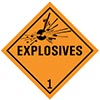
ADR Class 1
Explosives that may cause a fire or explosion. Most often it is pyrotechnics or articles intended for blasting works. At certain temperatures or pressures, they can cause a chemical reaction and explode. For the first ADR class there are 6 subclasses:
1.2. subclass - Substances and articles which have a projection hazard but not a mass explosion hazard;
1.3. subclass - Substances and articles which have a fire hazard and either a minor blast hazard or a minor projection hazard;
1.4. subclass - Substances and articles which have only a small risk of explosion in the event of ignition or initiation during transportation do not cause damage to the equipment or packaging;
1.5. subclass - Substances with very low sensitivity, which are characterized by the danger of a mass explosion, but which are so insensitive that their initiation or transition from combustion to detonation under normal transport conditions is unlikely;
1.6. subclass - Extremely insensitive against detonation articles with a low probability of accidental initiation or explosion propagation.
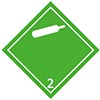
ADR Class 2
Pure gases, mixtures of gases, mixtures of one or more gases with one or more other substances and articles. The second class of ADR also includes compressed gas, liquefied gas, dissolved gas, as well as gas cylinders and aerosols. Gases are classified according to their hazardous properties: suffocating, oxidizing, flammable, toxic and corrosive. The 2nd ADR class has 6 subclasses:
2.1. subclass - non-flammable gases;
2.2. subclass - non-flammable and poisonous gases;
2.3. subclass - highly flammable gases;
2.4. subclass - highly flammable poisonous gases;
2.5. subclass - chemically unstable gases;
2.6. subclass - chemically unstable toxic gases.
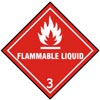
ADR Class 3
Highly flammable liquids, mixtures of liquids and liquids containing solids in solution or suspensions which emit flammable vapors. They can also be solids in the molten state or substances dissolved in water. The 8th ADR class is divided into 3 subclasses:
3.1. subclass - highly flammable liquids with a low flash point - liquids with a flash point in the closed crucible is less than minus 18 degrees Celsius or with a flash point together with other hazardous properties;
3.2. subclass - highly flammable liquids with a medium flash point - liquids with a flash point in the closed crucible is from minus 18 to plus 23 degrees Celsius.
3.3 subclass - highly flammable liquids with a high flash point - liquids with a flash point in the closed crucible is from plus 23 to plus 61 degrees Celsius inclusive.
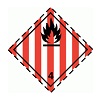
ADR Class 4
Flammable solids, self - reactive sites and solid desensitized explosives. They can also be materials that are at risk of ignition due to friction, moisture absorption or heating. Class 4 of the ADR is divided into 3 subclasses:
4.1. subclass - highly flammable, solid substances which are able to ignite from external sources of ignition (sparks, flames or friction) and actively burn;
4.2. subclass - self-igniting substances which, under normal conditions of transport, may become arbitrarily hot and ignite;
4.3. subclass - substances which emit flammable gases upon contact with water.
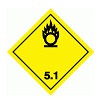
ADR Class 5
Organic peroxides and oxidizing substances which, when releasing oxygen, are capable of maintaining or causing fire or explosion when mixed with other substances. The 6th ADR class is divided into two subclasses:
5.1. subclass - oxidizing substances which are not flammable in themselves, but promote easy ignition of other substances and release oxygen during combustion, thereby increasing intensity of the fire;
5.2. subclass - organic peroxides, which in many cases are flammable, can act as oxidizing substances and are dangerous in contact with other substances. Many of them ignite easily and are sensitive to shocks and friction.
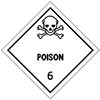
ADR Class 6
Substances which are infectious or poisonous are known or reasonably regarded as containing pathogens. These substances can cause death, poisoning or illness. The 6th ADR class is divided into two subclasses:
6.1. subclass - poisonous (toxic) substances which are capable of causing death by inhalation of vapors, dusts, absorption through skin or ingestion;
6.2. subclass - substances and materials containing pathogenic organisms that are dangerous to humans and animals.
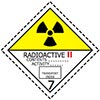
ADR Class 7
Radioactive substances (including those that may cause biological changes in contact with living cells, including human cells, depending on the type of tissue affected, the nature of radiation and other factors. Customs operations to verify content of radioactive cargo may be performed only by suitably qualified experts.
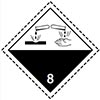
ADR class 8
Corrosive and poignant substances that can cause damage to the respiratory tract, mucous membranes and skin, as well as corrosion of metals, damaging the vehicle. These substances can also cause a fire in contact with organic materials or various chemicals. The 8th ADR class is divided into 3 subclasses:
8.1. subclass - acids;
8.2. subclass - alkalis;
8.3. subclass - various corrosive and poignant substances.
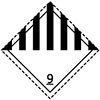
ADR class 9
Other dangerous goods of relatively low hazard during transport which do not fall into any of the above classes, but which require certain transport and storage regulations in order to be transported. The 9th ADR class is divided into two subgroups:
9.1. subclass - liquid and solid fuels and materials which are not included in classes 3 and 4, but in some cases may be dangerous (flammable liquids with a flash point from + 61 C to + 100 C in a closed crucible, fibers and other similar materials);
9.2. subclass - substances which become poignant under certain conditions and corrosive.
Transportation of dangerous goods
Our team consists of professional and certified drivers with long-term experience in the field of transportation of dangerous goods, who constantly update and upskill their knowledge, thus guaranteeing the safe and high-quality transportation of your dangerous goods. We are ready to perform transportation of your cargo in accordance with the standards, regardless of their level of complexity at any stage of transportation, because of needs:
Certified
We have all the necessary certificates and permits to make safe deliveries of dangerous goods of any hazard class. We will provide fast and advantageous cargo transportation to any place in the world - in Europe, CIS countries, as well as to the USA and from China.
Safety
Transport of dangerous goods or ADR goods transportation requires special attention and knowledge, starting with the preparation of documents and ending with proper transportation. Our vehicles comply with all safety standards specified in ADR convention.
Professionally
We will provide you with a free professional consultation, during which we will answer all your questions about transport of dangerous goods. We will also inform you about necessary licenses, permits and formalities that are necessary for your cargo transportation to be safe, fast, profitable!
Working with Vervo will ensure a pleasant experience!
Contact our transport manager who will be ready to answer your questions! With us, transportation of dangerous goods is especially safe, convenient and profitable!
